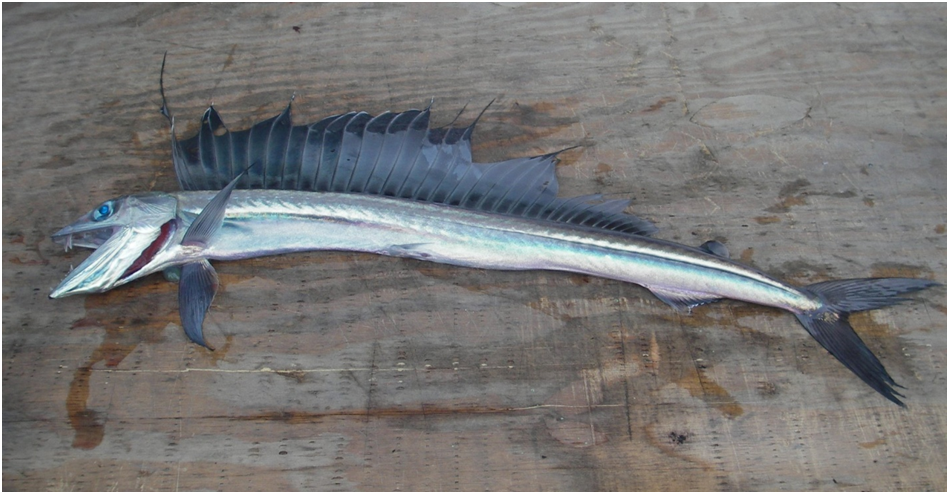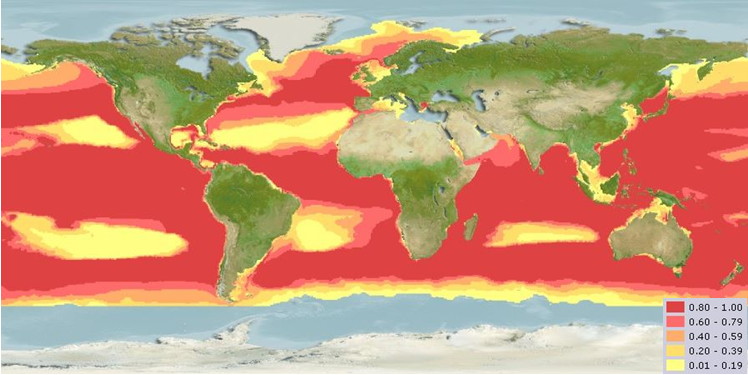Employees of the Commander Islands Nature and Biosphere Reserve found an unusual marine "beast" on the coast of Bering Island. This creature from nightmares, whose mouth ominously sparkles with numerous teeth, including the sharpest 3-centimeter fangs growing directly from the palatine bone, is called the handsaw fish(Alepisaurus ferox Lowe, 1883). For the first time, the fish was described by the famous participant of the Second Kamchatka Expedition, Georg Steller, who discovered it off the Kuril Islands in 1741. The name Alepisaurus, or a scaleless beast, was given to this fish in 1811 by Peter Pallas, a famous researcher of the fish fauna of the Far Eastern seas, and the English priest and botanist R.T. Lowe in 1833 (Orlov, Ulchenko, 2004).
%20для%20Insta.jpg)
Figure 2. A snapshot of the head of a detected Alepisaurus in profile. Author - Mikhail Vakurov

Figure 3. Alepisaurus ferox in its entirety. Photo by Allen Shimada, NOAA NMFS OST (United States National Oceanic and Atmospheric Administration)
This fish is amazing not only in appearance. Alepisaurus reach a length of 215 cm, and the mass can reach up to 9 kg (Romanov, Zamorov, 2002). In summer, this species is often found in the waters of the Russian Far East, despite the fact that its characteristic habitats are the tropics and subtropics. This is due to the fact that during feeding season, alepizaurs penetrate far to the north, reaching the coast of Greenland, Iceland and entering the Bering Sea that we all know (Orlov and Ulchenko, 2004).

Figure 4. Map of the water area in which the Alepisaurus can dwell. The colors reflect the likelihood that Alepisaurus ferox is in the designated habitat. Source: Global Biodiversity Information Facility and The Ocean Biogeographic Information System (GBIF OBIS).
Alepizaurs are deep-sea predatory fish, they hunt at a depth of approximately 200 to 1000 meters (Shevlyakov, Parensky 2012). The composition of their diet includes a wide variety of animals: fish, cephalopods, shellfish, crustaceans, etc. Their diet is of particular interest in the context of the impact on populations of salmon fish spawning in the Far East, including the Commander Islands. Injuries to Pacific salmon by Alepisaurus are the second most common after injuries left by pinnipeds. Alepisaurus often themselves become prey of larger fish - tuna, marlin, sharks and many other marine predators eat it (Orlov and Ulchenko, 2004). Like many fish living in depth, Alepisaurus have daily vertical migrations: at night - closer to the surface, and in the afternoon - back to depth.
.png)
Figure 5. O. nerka, caught in the Gavanskaya river with the characteristic bite of a handsaw fish. Two clean cuts from twin fangs are clearly visible. Author - Mikhail Vakurov
Interesting facts about Alepisaurs:
- These fish are characterized by cannibalism - smaller and more unsuccessful Alepisaurus were found in the stomachs of their relatives;
- The sexual process of alepizaurs is practically not studied - it is only known that hermaphroditism is characteristic of the species (the development of both male and female genital organs in one individual);
- The population of alepizaurs in the Far Eastern waters, according to scientists, is half a million individuals (Melnikov, 1997);
- Many handsaw fish are periodically found ashore without any damage or traces of the disease. Their death is associated with periodic cooling in the northern part of the Pacific Ocean during the action of La Nina (Orlov and Ulchenko, 2004).
Caption: Snapshot of the head of the Alepisaurus. Characteristic fangs growing from the palatine bone are clearly visible. Author - Mikhail Vakurov










